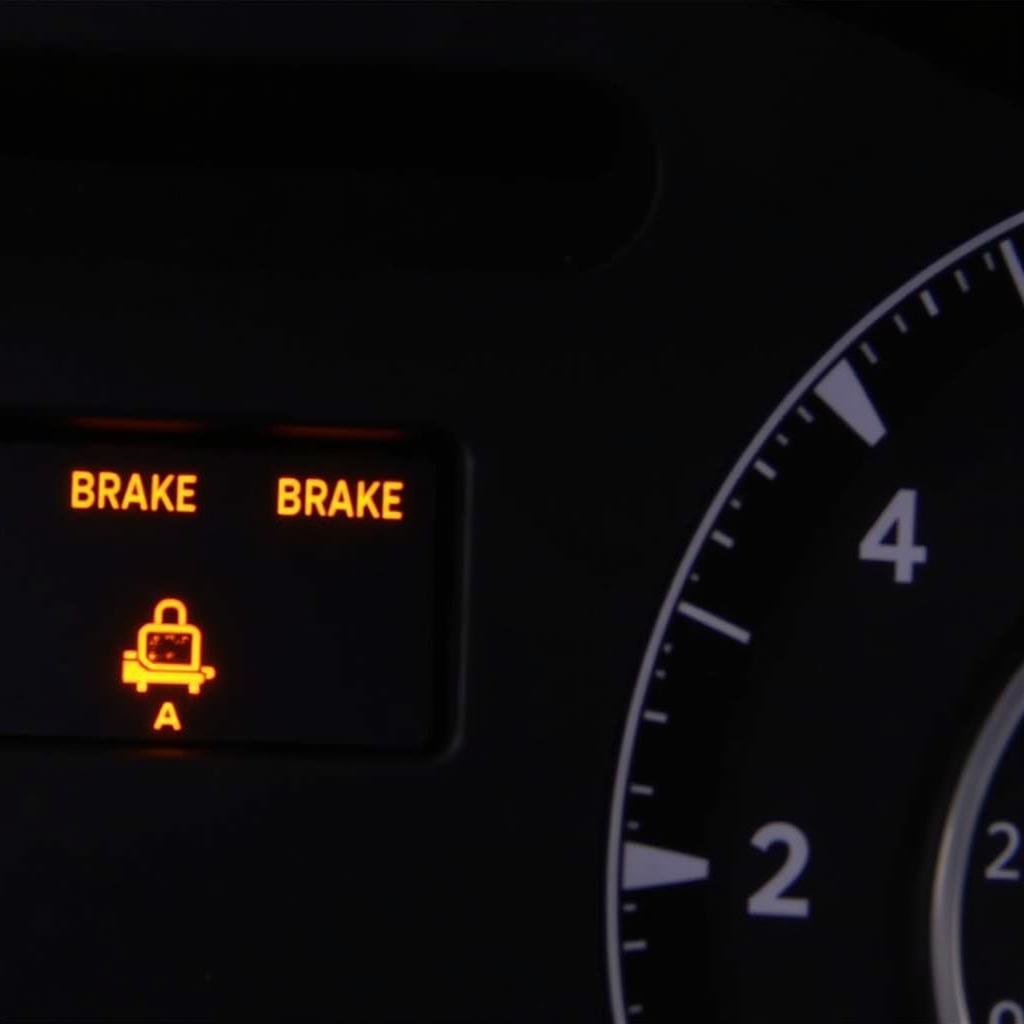The dreaded dash brake warning light. It can illuminate for a myriad of reasons, causing concern and confusion for any 2008 F150 5.4-liter owner. Is it a minor hiccup or a sign of a serious issue? This guide dives deep into the common causes, troubleshooting tips, and potential solutions for a 2008 F150 5.4-liter displaying a persistent brake warning light.
Decoding the Dash: What Does the Brake Warning Light Mean?
The brake warning light, often accompanied by the message “BRAKE” on the dash, serves as a crucial communication tool between your F150 and you. It signals a potential problem within the braking system, which could stem from various sources.
 2008 F150 Brake Warning Light on Dashboard
2008 F150 Brake Warning Light on Dashboard
Common Culprits Behind the Illuminated Brake Light
While the brake warning light itself doesn’t pinpoint the exact issue, it narrows down the potential culprits to the braking system. Here are some of the most common reasons why your 2008 F150 5.4-liter might be displaying this warning:
- Low Brake Fluid: This is the most frequent offender. Brake fluid, crucial for transmitting force when you press the brake pedal, can decrease over time due to leaks or worn brake pads.
- Worn Brake Pads: Brake pads have wear indicators designed to activate the warning light when they reach a certain level of wear.
- Faulty Brake Light Switch: Located behind the brake pedal, this switch signals the brake lights to illuminate when you brake. A malfunctioning switch can trigger the warning light.
- ABS System Malfunction: While less common, issues within the Anti-lock Braking System (ABS), such as a faulty sensor, can trigger the brake warning light.
- Parking Brake Engaged: Sometimes, the simplest explanation is the most likely. Make sure your parking brake is fully released as even a slight engagement can activate the light.
Troubleshooting Your 2008 F150 5.4 Liter’s Brake Warning Light
Before heading to the mechanic, there are a few troubleshooting steps you can take to potentially identify the problem:
- Check Your Brake Fluid Level: Locate the brake fluid reservoir under the hood (consult your owner’s manual if needed) and check the fluid level. If it’s low, adding brake fluid might temporarily resolve the issue, but it’s crucial to have the system inspected for leaks.
- Inspect Your Brake Pads: Visually examine your brake pads through the wheel spokes. If they appear excessively thin or you notice metal-on-metal contact, it’s time for a replacement.
- Test Your Brake Lights: Have a friend or family member observe your brake lights while you press the pedal. If they don’t illuminate, the brake light switch might be faulty.
When to Seek Professional Help
While simple fixes like adding brake fluid or replacing brake pads can be handled by DIY enthusiasts, it’s best to consult a qualified mechanic if:
- The brake warning light remains illuminated after adding brake fluid.
- You suspect a brake fluid leak.
- Your brake pedal feels spongy or goes all the way to the floor.
- You hear unusual noises (grinding, squealing) when braking.
- The ABS light is also illuminated.
 Checking Brake Fluid Level in 2008 Ford F150
Checking Brake Fluid Level in 2008 Ford F150
Keeping Your 2008 F150 5.4 Liter’s Brakes in Top Shape
Preventing brake issues is always preferable (and less costly) than addressing them after they arise. Here are some preventative measures to keep your F150’s brakes in optimal condition:
- Regular Brake Inspections: Have your brakes inspected annually or every 12,000 miles, whichever comes first.
- Timely Brake Fluid Flushes: Aim to flush your brake fluid every 2-3 years or as recommended in your owner’s manual.
- Quality Brake Pads: Invest in high-quality brake pads from reputable brands for optimal performance and longevity.
The Final Word: Don’t Ignore the Warning
A glowing brake warning light should never be ignored. While it might signal a minor issue, it could also indicate a more serious problem that requires immediate attention.
“As an automotive technician specializing in F-series trucks, I can’t stress enough the importance of addressing brake issues promptly. Ignoring a brake warning light can lead to costly repairs down the line and, more importantly, compromise your safety on the road.” – John Miller, Certified Automotive Technician
By understanding the potential causes, following the troubleshooting tips, and seeking professional help when needed, you can ensure your 2008 F150 5.4-liter’s braking system remains in optimal condition, providing you with a safe and reliable driving experience.

